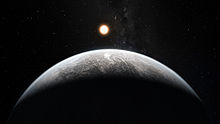HD 85512
| Observation data Epoch J2000 Equinox J2000 | |
|---|---|
| Constellation | Vela |
| Right ascension | 09h 51m 07.0520s[1] |
| Declination | −43° 30′ 10.0220″[1] |
| Apparent magnitude (V) | 7.66 |
| Characteristics | |
| Spectral type | K6V[2] |
| U−B color index | 1.12 |
| B−V color index | 1.18 |
| V−R color index | 0.71 |
| Astrometry | |
| Radial velocity (Rv) | −9.6 km/s |
| Proper motion (μ) | RA: 461.446±0.103[1] mas/yr Dec.: −472.010±0.116[1] mas/yr |
| Parallax (π) | 88.6158 ± 0.0406[1] mas |
| Distance | 36.81 ± 0.02 ly (11.285 ± 0.005 pc) |
| Absolute magnitude (MV) | 7.39[3] |
| Details[2][4] | |
| Mass | 0.69 M☉ |
| Radius | 0.533 ± 0.04[note 1] R☉ |
| Luminosity (bolometric) | 0.126 ± 0.008 L☉ |
| Surface gravity (log g) | 4.604±0.017 cgs |
| Temperature | 4404±10 K |
| Metallicity | ([Si/H] dex) -0.02 |
| Metallicity [Fe/H] | -0.28 dex |
| Rotation | 47.13 ± 6.98 |
| Rotational velocity (v sin i) | 2.194±0.118 km/s |
| Age | 5.61 ± 0.61 Gyr |
| Other designations | |
| Database references | |
| SIMBAD | data |
HD 85512 is a solitary K-type main-sequence star about 37 light-years away in the constellation Vela. It is about 1 billion years older than the Sun. It is extremely chromospherically inactive, only slightly more active than Tau Ceti. It exhibits a long-term variability[2] and is known to host one low-mass planet.
Planetary system[]

On August 19, 2011, a ≥3.6 Earth-mass planet was discovered using HARPS that is "just inside" the habitable zone, along with: inner planets of e (or 82 G.) Eridani; and HR 7722 c in Capricornus. These two comparator sets are at about 2⁄3 of the subject's distance from Earth.[7] The subject planet could be cool enough to host liquid water if it has more than 50% cloud coverage. For a time it ranked fifth-best for habitability in the Habitable Exoplanets Catalog, which later lists it under false starts as "too hot".[8]
| Companion (in order from star) |
Mass | Semimajor axis (AU) |
Orbital period (days) |
Eccentricity | Inclination | Radius |
|---|---|---|---|---|---|---|
| b | ≥3.6 M |